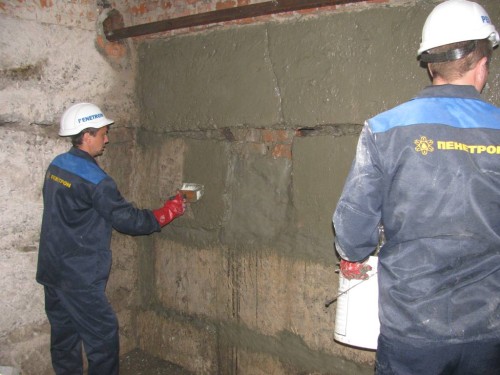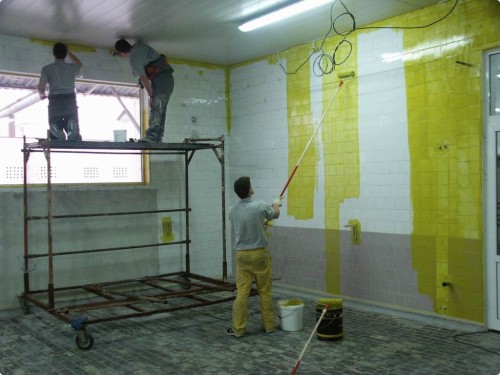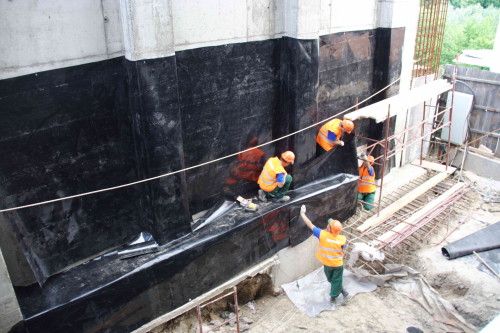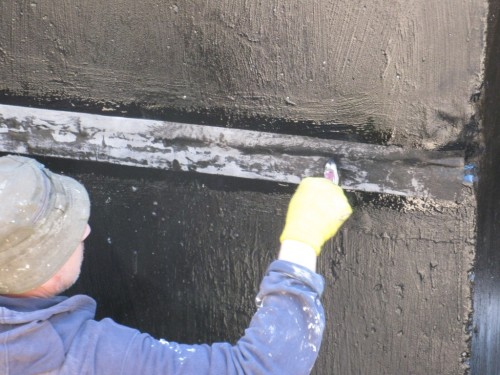To date, the urgent problem of many buildings is dampness, an increased level of humidity. It is immediately worth noting that the whole problem is based on the penetration of moisture inside the structure. If we talk directly about residential premises, then exist in conditions of high humidity is a real test. Dampness is a phenomenon that, among other things, negatively affects human health. In addition, one cannot bypass the fact that, due to the constant action of moisture, the structure itself begins to lose its strength, presentability and the rest of the most important characteristics.
Content
In this situation, the only way out is the arrangement of high -quality wall waterproofing. The situation is in such a way that for walls now there is simply a tremendous amount of materials that can stop the effect of moisture. Moreover, we can talk about external and internal insulating materials.
Experts note that the need for waterproofing primarily applies to walls on the first floors of structures, as well as in the basements and at the level of the foundation of the house. In other cases, there is practically no need for waterproofing. Of course, it is worth approaching this issue as responsibly as possible, since the issue of isolation of the house from moisture is often relevant.
In the article we will consider the main issues related to the waterproofing of the walls of the house. In addition, we will not bypass the features of this process within other objects. We analyze the waterproofing process, which often has a number of features.
Features of waterproofing walls and the specifics of moisture action
To begin with, it is worth keeping in mind that moisture is actually a serious enemy of the dwelling. If the walls cope with small precipitation without any auxiliary materials, then in the case of regularly increased humidity the situation is not easy.
Most often, the problem is that there is a certain temperature difference inside and on the street, and in this situation, moisture condenses. To establish whether this problem exists, you do not need to be a specialist. It is enough to look at the walls and make sure that they are a little wet.
The problem is also the following reasons:
- Unfortunately, most of the finishing materials actively absorb moisture, so if you do not start to act on time, then the coating will completely become unsuitable for further use. It is good if the finishing material can be easily dismantled and after some events are returned to the wall again. If the finishing resource is ordinary consumables, then when conducting waterproofing, you will just have to get rid of the finish.
- If we talk about communications inside the house, then many people have metal pipes, which, of course, under the influence of moisture become a victim of corrosion. Over time, such pipes will become unusable, so the need for waterproofing again has a place to be. It is especially bad if the problem is brought to such an extent that even after waterproofing, most of the communications will have to be changed. Therefore, it is worth acting as quickly and efficiently as possible.
- Surely the most serious problem that the tenants of the house immediately pay attention to is the smell of dampness. It is probably known to many people, since often the smell is present in various basements, cellars, garages and the like. If such a smell appeared within the framework of the dwelling, then things are really bad. In such conditions, it is extremely difficult to exist, and dampness can extremely negatively affect human health, because in this situation, various microorganisms appear in the house. It should be acted as quickly as possible to get rid of humidity, and then hold measures related to cleaning space. The most serious problem is the appearance of mold, and in order to get rid of it to the fullest, it may require the help of third -party specialists.
- Violation of the microclimate inside the house is also an important point that entails extremely serious consequences. With regular effects of humidity in the house, it will be cool enough, even if the street is unbearable heat. In the winter, indoors may be even cooler than on the street, and heating will not demonstrate proper effectiveness.
Having analyzed the above points, it becomes clear that there is still the need for waterproofing walls. At the same time, do not forget that the cause of high humidity should be in advance. By the way, the reasons can be very diverse. However, the most important thing is to get rid of those moisture sources that, even when arranging high -quality waterproofing, will make themselves felt. For example, this may not be the most successful design of the roof of the house, due to which humidity spreads through the walls. There can be a huge number of similar examples, so it always makes sense to check all possible options associated with the influence of moisture.
The main types of waterproofing by purpose
To date, hundreds of manufacturers offer many insulating materials that differ in certain characteristics. And first of all, it is worth sharing waterproofing materials for its intended purpose:
- Anti -corrosion. In this case, we are talking about protecting space from aggressive waters and liquids. Most often, this waterproofing is used to cover various metal elements. In most cases, anti -corrosion isolation finds its use in industrial conditions, and within the framework of dwellings, this is a rare phenomenon.
- Sealing. This is the most common hermetic material that prevents moisture from entering the room. Most often, it is this resource that is used to cover the walls, foundations and other objects on which moisture affects.
- Anti -Field. This waterproofing is often used to cover surfaces within the framework of basements and other underground structures. Often such resources are used in fairly severe conditions, when water sources have a direct effect on the object. For example, it can be a space located under the dam.
- Toplijections. Such materials, again, are most often used in the framework of industry. For example, we can talk about pipeline communications that need to be insulated and protected from leakage. Teplogi-insulation in the best way demonstrates the effectiveness precisely in the above conditions, but in some other situations there will be no particular use from it.
Waterproofing objects
In this material, we are talking directly about the waterproofing of walls, but it should be borne in mind that there are a lot of objects within which this event can carry out. Thus, we are talking about the following places:
- Basements.
- Floors.
- Sanitary nodes.
- Walls.
- Foundations.
Obviously, you should pay attention to all the presented waterproofing options, since situations often occur when the owners give in to the insulation completely different objects, and in the end it turns out that the funds are spent in vain, and there is no sense from this.
The specifics of waterproofing basement walls
It is immediately worth saying that today the waterproofing is often mounted within the basement. This is exactly the space that requires reliable protection against moisture and water. In the event that moisture still breaks into the basement, the consequences may be too negative. At the same time, it is worth keeping in mind that the basement often requires really reliable protection, and here we are no longer about using paint waterproofing resources, but of some other types of materials.
It is also impossible to bypass the information that waterproofing walls within the basement can be done at any time, however, it is recommended to do the entire amount of work immediately after construction. Then you can be sure that the space is in good condition.
- The anti -navigable type of insulation for basement is a resource that in the best way protects the space from the effects of groundwater. For this case, mastics based on polymers and bitumen are often used. There is no doubt about the reliability of this protection.
- The non -cognitive type of insulation is protection against various precipitation, as well as from the influence of melt water. It is worth paying attention to the fact that today this is the most relevant option for protecting the basement, since most often the above factors affect the basement. It is interesting that all the same bituminous and polymer mastics can be used as such protection.
- The anti -capical type of insulation is often used at the floor level, since it is here that small drops often arise that penetrate the smallest pores in the floor. This is an urgent problem for many owners, although at first glance it should not create special inconvenience. Most often, mastics, solutions and some impregnation mixtures are used to get rid of this trouble, which differ in effectiveness when getting rid of small pores.
Separately, I would like to say that much depends directly on the existing space. We can talk about the features of the layout, the building materials used and much more. It is important to draw attention to the fact that today many isolations are excellent effectiveness, however, it is worth paying attention to the purpose of the resource, as well as its small features.
Most often, the process of preparing for waterproofing walls of the basement includes the following steps:
- First of all, the surface is completely cleaned. The basement is a specific space, which often becomes quite contaminated, especially if vegetables and various things are stored there. Thus, it is worthwhile to clean the most qualitatively so that the effectiveness of the isolation used is at the highest level.
- Next, you need to pay attention to any irregularities present on the surfaces. This is especially true for walls that can have various flaws. And it is precisely these shortcomings that are most often manifested during construction, or already in the process of using space. Thus, it always makes sense to align the walls, and thanks to this, not only the appearance of space will improve, but also the effectiveness of the waterproofing used. It is enough to carry out a rough or black leveling so that it gives a positive effect in the future.
- Now the time of drying the walls comes. Immediately before applying waterproofing, the surface should be as dry as possible as possible, so that a high -quality adhesion of the material with the wall will ultimately occur.
Next, it is worth considering in more detail the process of using roller waterproofing materials:
- First, the walls are plastered with a cement mortar.
- Now you need to arm yourself directly with rolls of waterproofing material, and apply it in 2 layers to the surface.
- After placing the material, a wall of clay brick is built. It is placed at a distance of 0.5 from the main wall and is necessary to support roll insulation. It should be borne in mind that between insulation and the created surface, the void is filled with soil.
- Further, all joints and possible cracks are coated with a mastic based on bitumen.
- Well, at the very end, it will not prevent the processing of the resulting surface with the coating mixture, which will also differ in waterproofing properties.
It is this method of isolation that is most often recommended by experts for use within the basement. This is the most effective option for struggle with various ways of moisture and water in the moisture and water. It should be borne in mind that additional protection will never be superfluous.
Waterproofing walls inside the apartment
Obviously, too serious influences associated with moisture from entering the apartment often do not exist. Despite this, it definitely makes sense to protect your home, especially if there are small problems with dampness and other aspects.
Increased humidity, first of all, manifests itself in the corners (moistened areas of walls). This, so to speak, is the first bell that indicates the need for immediate waterproofing, otherwise the situation later can significantly deteriorate.
- First of all, it makes sense to insulate the cracks. For this case, it will be necessary to prepare a fine with a cross section of about 20x20 mm. After that, it is necessary to fill out the voids using mounting foam.
- The second step is still the same surface cleaning. As we already mentioned earlier, speaking of the waterproofing of the basement. It makes sense to remove all the dirt and dust that is on the surface. It is also worth considering that there can be coatings (wallpaper, panels, other materials) on the surface, which also need to be removed, otherwise the main waterproofing process may not be the most effective.
- Ultimately, the concrete surface is coated with a special waterproofing composition.
It is interesting that often for a qualitative result, it is enough to use a special solution, which most often looks like cement material, however, there are some additives that contribute to getting rid of moisture or water. These additives begin to act at the moment when even the smallest action of moisture occurs. The coating begins to block small channels, through which moisture or liquid could penetrate. Accordingly, if the moisture could not go further, then no fungi and other organisms, usually appearing with high humidity, will not be in sight. At the same time, do not forget that the effect of water or moisture can be too intense, and in such situations it makes sense to conduct a complete analysis of the current situation and choose the most suitable waterproofing material. Attention should be paid to the fact that in modern construction, the waterproofing of walls from the inside of the dwelling is carried out in almost all cases, so the need for this process is obvious.
Waterproofing of the external walls of the house
External waterproofing of the house is not carried out so often, but often it becomes extremely useful. Most often, waterproofing is used at the foundation level, since it often affects various influences, including groundwater and much more. The waterproofing of the walls of the house is also recommended in certain situations, and this issue must be approached as responsibly as possible.
- First of all, the surface is prepared for waterproofing. This is that the walls are often present on the walls and other things that make the process of waterproofing impossible. In addition, you need to get rid of the stains of oil and traces of rust. Immediately after cleaning, the surface can be wet, and under such conditions, waterproofing is not carried out. It is advisable to dry the surface, often, if it is necessary to quickly carry out the process, heat guns are used.
- Next, you need to create the basis for waterproofing, and often it is a regular primer. It is interesting that experts often advise heating the primer and wall, which will significantly improve the clutch.
The use of coating waterproofing (for brick, reinforced concrete structures) is a fairly effective option, given the fact that this material often penetrates even the smallest pores on the surface. Ultimately, protection against moisture and water at a fairly high level. However, there is also a need for a drainage system that will divert rain moisture and other precipitation, which have a serious impact on the condition of the walls. If we talk specifically about the materials, then we are talking about the following products: Askoville, Cemizol, Strites 2000. These resources are highly effective even in fairly harsh weather conditions.
Penetrating waterproofing is often used for houses built on the basis of reinforced concrete. In this case, the wall is cleaned using sandblasting equipment, and then the coating occurs. The material is distinguished by excellent permeability, which can minimize the effects of even minimal humidity. It is also important to remember that between the joints of building materials, it often is found with suture materials.














